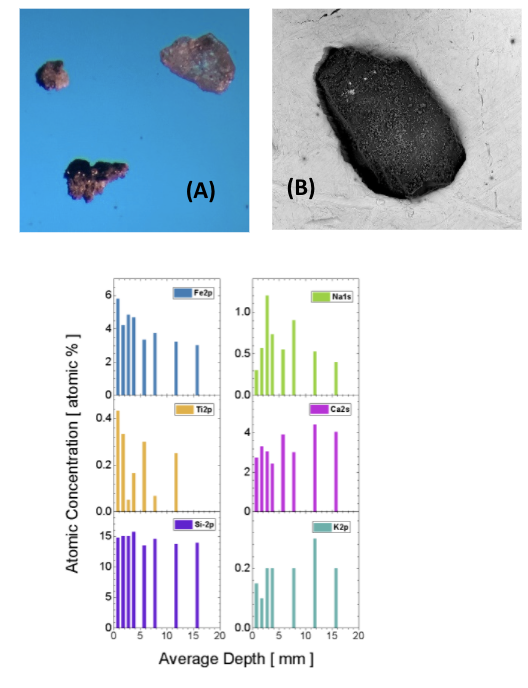Consortium for the Advanced Analysis of Apollo Samples
Stratigraphic Variation in Grain Surface Chemistry Within Apollo Core Sample 23002 Using X-Ray Photoelectron Spectroscopy
Half-a-century after the Apollo 11 manned-landing on the lunar surface, NASA released a number of previously unexamined core samples for analysis by new/improved scientific techniques. This pristine regolith includes landslide material collected near Station 3 within the Taurus-Littrow Valley on the southeastern edge of Mare Serenitatis [1-3]. Double-drive tube samples from Apollo 17: 73002 (upper ~22 cm) and the 73001 (below ~22 cm) are p art of the released samples, where 73001 has been stored since 1972 in a Core-Sample Vacuum Container (CSVC) to better retain lunar volatile species (H2O, Na, K, etc.). Sample 73001 has remained sealed since lunar acquisition. Native stratigraphy of the collected material remains preserved in the tubes, allowing analyses of grain composition, volatile content, and space-weathering products to be evaluated as a function of depth.
art of the released samples, where 73001 has been stored since 1972 in a Core-Sample Vacuum Container (CSVC) to better retain lunar volatile species (H2O, Na, K, etc.). Sample 73001 has remained sealed since lunar acquisition. Native stratigraphy of the collected material remains preserved in the tubes, allowing analyses of grain composition, volatile content, and space-weathering products to be evaluated as a function of depth.
XPS was used to determin the surface composition of 2-5 lunar grains within each interval, regardless of parent mineralogy. All grains were found to contain: O, Si, Al, Mg, Ca, Fe, Na, C, and F, with many grains also retaining Ti, K, and S throughout the entire 73002 core. Identified species are similar to elemental bulk compositions as measured by EDAX, which additionally noted Cr, Mn, and Mo in low concentrations in some particles; F was not noted in the bulk analysis. Subsequent XPS analysis of grains (73002, 257) after in situ sputtering by 1 keV H removes much of the F, which appears to be ≤ 1 mono-layer, and may be the result of sample collisions with the PTFE-capped containers during transport.
Preliminary analysis of XPS measurements describe trends in elemental surface (< 10 nm) concentrations with stratigraphy usiung the average composition of all grains within each 5 mm interval. We find that volatile species (Na, K, S) and Ca are depleted in the surface segments relative to their concentrations deeper in the core, while Fe, and Ti are conversely enriched over the near-surface intervals. Si and O content appear relativeky conversely enriched over the near-surface intervals. Si and O content appear relatively constant throughout the 73002 core. C was identified, likely adventitious in nature, rather than endogenous to the Moon.
Support: NASA/UNM/NASA-JSC (10/16/2019 thru 10/15/2022)
PI: Chip Shearer (UNM)
Co-I/UVa-PI: Catherine Dukes (Research Scientist)
UVa Contributors: Adam Woodson (Research Scientist); Kamil Stelmach (Graduate Student); Jillian Maxson (Astronomy/Physics Undergraduate); Linda Ziamanesh (Chemistry Undergraduate); Jessica Oraegbu (Computer Science Undergraduate); Tin Ho ( Environmental Sciences Undergraduate)
Proceedings and Publications:
C.K. Shearer, F.M. McCubbin, H.H. Schmitt, S. Eckley, R.A. Zeigler, J. Gross, J. Mitchell, S.B. Simon, A. Meshik, F. McDonald, C. Krysher, R.V. Morris, M. Neuman, K. Wang, B.L. Jolliff, K. Joy, Z. Sharp, M. Cato, A. Gargano, A. Mosie, J. Allton, C. Amick, C. Dukes, R. Parai, J. Simon, J.J. Barnes, M. Dyar, K. Burgess, N. Petro, N.M. Curran, J.E. Elsila, J. Gillis-Davis, A. Sehlke, D. Sears, B. Cohen, O. Pravdivseva, M.S. Thompson, C.R. Neal, P. Lucey, L. Sun, R. Hanna, R. Ketcham, and the ANGSA science team, “Apollo Next Generation Sample analysis (ANGSA): An Apollo participating scientist program to prepare the lunar sample community for Artemis,” Space Science Reviews – accepted May 2024
C. A. Dukes, K. B. Stelmach, A. K. Woodson, L. Ziamanesh, J. Oraegbu, R. V. Morris, L. P. Keller, R. Christoffersen, C. K. Shearer, and the ANGSA Science Team, Stratigraphic Variation in Grain Surface Chemistry within Apollo Core Sample 73002 using X-ray Photoelectron Spectroscopy, 53rd LPSC Abstract# 2935 (2022)